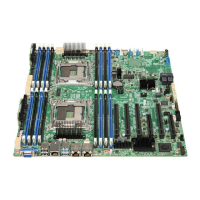Intel® Server Board S2600CW Platform Management Intel® Server Board S2600CW Family TPS
66 Revision 2.4
system and the availability of the physical sensor when in that state. For example, non-
standby voltages are not monitored when the system is in S4 or S5 power state.
5.3.2 Sensor Rearm Behavior
5.3.2.1 Manual versus Re-arm Sensors
Sensors can be either manual or automatic re-arm. An automatic re-arm sensor will "re-arm"
(clear) the assertion event state for a threshold or offset if that threshold or offset is
de-asserted after having been asserted. This allows a subsequent assertion of the threshold or
an offset to generate a new event and associated side-effect. An example side-effect would be
boosting fans due to an upper critical threshold crossing of a temperature sensor. The event
state and the input state (value) of the sensor track each other. Most sensors are auto-rearm.
A manual re-arm sensor does not clear the assertion state even when the threshold or offset
becomes de-asserted. In this case, the event state and the input state (value) of the sensor do
not track each other. The event assertion state is "sticky". The following methods can be used
to re-arm a sensor:
Automatic re-arm – Only applies to sensors that are designated as “auto-rearm”.
IPMI command Re-arm Sensor Event.
BMC internal method – The BMC may re-arm certain sensors due to a trigger condition.
For example, some sensors may be re-armed due to a system reset. A BMC reset will
re-arm all sensors.
System reset or DC power cycle will re-arm all system fan sensors.
5.3.2.2 Re-arm and Event Generation
All BMC-owned sensors that show an asserted event status generate a de-assertion SEL event
when the sensor is re-armed, provided that the associated SDR is configured to enable a
de-assertion event for that condition. This applies regardless of whether the sensor is a
threshold/analog sensor or a discrete sensor.
To manually re-arm the sensors, the sequence is outlined below:
1. A failure condition occurs and the BMC logs an assertion event.
2. If this failure condition disappears, the BMC logs a de-assertion event (if so configured).
3. The sensor is re-armed by one of the methods described in the previous section.
4. The BMC clears the sensor status.
5. The sensor is put into "reading-state-unavailable" state until it is polled again or otherwise
updated.
6. The sensor is updated and the “reading-state-unavailable” state is cleared. A new
assertion event will be logged if the fault state is once again detected.
All auto-rearm sensors that show an asserted event status generate a de-assertion SEL event
at the time the BMC detects that the condition causing the original assertion is no longer

